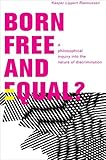Born free and equal? : a philosophical inquiry into the nature of discrimination / Kasper Lippert-Rasmussen. [print]
Material type: TextPublication details: Oxford ; New York : Oxford University Press, (c)2014.Description: xii, 317 pages ; 25 cmContent type:
TextPublication details: Oxford ; New York : Oxford University Press, (c)2014.Description: xii, 317 pages ; 25 cmContent type: - text
- computer
- online resource
- 9780199796113
- HM821.L765.L577 2014
- HM821
- COPYRIGHT NOT covered - Click this link to request copyright permission:
| Item type | Current library | Collection | Call number | Status | Date due | Barcode | |
|---|---|---|---|---|---|---|---|
 Circulating Book (checkout times vary with patron status)
Circulating Book (checkout times vary with patron status)
|
G. Allen Fleece Library CIRCULATING COLLECTION | Non-fiction | HM821 .L57 2014 (Browse shelf(Opens below)) | Available | 31923001635347 |
Introduction -- What is discrimination? -- Indirect discrimination -- Statistical discrimination -- Mental-state-based accounts -- Objective-meaning accounts -- Harm-based accounts -- Discrimination and the aim of proportional representation -- Discrimination in punishment -- Reaction qualifications -- Discrimination in the private sphere -- Racial profiling.
"What is discrimination? There are certain instances of differential treatment that almost anyone would describe as discriminatory; yet upon deeper examination, this near-unanimity gives way to disagreement and difference. For instance, is it discrimination when hospitals hire non-smokers only? Not only do people differ on which cases of differential treatment they see as discriminatory, they also disagree about when discrimination is morally wrong; what makes it morally wrong; and, indeed, about whether all forms of discrimination are morally wrong! Finally, many disagree over what should be done about wrongful discrimination--especially about what the state could permissibly do to eliminate wrongful discrimination, e.g. in people's love lives. This book addresses these issues. It argues that there are different concepts of discrimination and that different purposes pertaining to different contexts determine which one is the most useful. It gives special attention to a concept of discrimination that ties discrimination to differential treatment of people on the basis of their membership in socially salient groups. Second, it argues that when discrimination is wrong, it is so first and foremost because of its harmful effects. Third, it takes issue with some of the standard devices used to counteract discrimination and submits that combating discrimination requires more than state actions. Finally, it argues that states may sometimes permissibly discriminate."--Jacket.
COPYRIGHT NOT covered - Click this link to request copyright permission:
There are no comments on this title.
